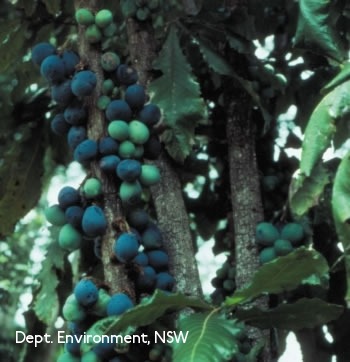The Davidson’s plum has attractive foliage and brilliant coloured fruit. It is one of the thousands of native edible plants, yet not many people know this. Native to the rainforests of Queensland and NSW. It was enjoyed by Aboriginal people and is now popular with chefs around the country – particularly for jams, sauces, chutneys and even wine.
It is believed plants made up the bulk of the traditional Aboriginal diet. Their plant knowledge was extensive and included the whereabouts, relative tastiness, time of harvest of crops of yams, edible roots and flowers, berries, fruits and nuts. They also used the small seeds of native grasses to grind and make into bread.

The Davidson’s plum has attractive foliage, brilliant coloured fruit – dark blue/purple on the outside and a deep reddish-pink on the inside. It might resemble the shape of the European plum, but they are not closely related and the native plum is far more sour than the fruit we are used to.
There are three species of the fruit: Davidsonia jerseyana, Davidsonia johnsonii and Davidsonia pruriens. All three trees are slender, but D. pruriens, also known as Ooray or Queensland Davidson’s plum, is tallest, growing up to 12 metres high. There are a few small-scale plantations producing the fruit in New South Wales and Queensland. D. jerseyana, native to lowland subtropical NSW, is considered endangered in the wild, but is widely cultivated. It reaches five metres high. D. johnsonii is a small tree with a spreading canopy and smooth leaves, also considered an endangered species in the wild.
Position
Davidson’s plum prefers warmer climate zones but will tolerate cooler regions if protected from frost. Being a native rainforest tree, the plant is best grown in a sheltered, part-shaded position in the garden with ample moisture and protection from damaging winds.
Soil and Fertility
The trees are found in their native habitat across a range of soil types. However, they appear to do best in deep, friable soils with plenty of organic material. They require good irrigation (or high natural rainfall), especially during flowering and fruiting.
Flowering and Fruiting
Flowers vary in colour from red through to pink, depending on the species. Fruits are borne either in panicles or grouped on the stem, again depending on the species. D. pruriens has larger fruit than the other species and they are produced in large clusters from the trunk or branches.
The fruit of D. jerseyana appear in early to mid-summer. Trees will bear in year 3.
D pruriens bears fruit in winter in its natural habitat but in cultivation, fruiting may extend to other seasons. This species will bear in year five or six or later.
Propagation
Fruit of D. johnsonii is infertile so propagation is done by clump division, cuttings or from suckers. The other species can be propagated by seed as well as the other methods. Davidson’s plum can be found in some nurseries around the country including Melbourne. It can also be ordered online.
Pests and Diseases
D. jerseyana is susceptible to fruit fly infestation. There are a number of sustainable ways to combat the fruit fly. These include: regular inspection for the presence of fruit fly larvae; setting traps; collecting fruit that has fallen to the ground, put in a sealed plastic bag and leave in the sun for 3-7 days; and employing chickens to scratch around under the tree to eat the larvae.
Birds, possums and flying foxes enjoy the fruit, so netting the trees at the appropriate time is wise. Caterpillars, moth larvae and beetles also attack flowers and fruit.
Pruning
Height is controlled by pruning off the tips. This also encourages multiple stems and fruiting.
Harvesting
Fruit picked just as it is beginning to turn purple will ripen readily off the tree. This will minimise the build-up of pests and prevent fruit falling to the ground to attract rodents.
Uses
In fact, Davidson’s Plum is not recommended for eating fresh but is excellent stewed, or preserved or made into jam using recipes for European plums. Some say you should double the amount of sugar that you would use in such a recipe. The flesh can be used in savoury dishes as well.
One of the impressive things going for the Davidson’s plum is its nutrients. It has more antioxidants than the blueberry, which is known worldwide for health benefits. It also contains potassium, lutein (a compound important for eye health), vitamin E, folate, zinc, magnesium and calcium.
It is best to eat the skin as well as the flesh of the fruit as the skin contains most of the nutrients.
Another benefit of Davidson’s plum is its intense colouring which can act as a natural food colour.
Meanwhile, research is being done into its preservative properties. When tested on some meats, a product made from Davidson’s plum extended the shelf life of the meat by 21 days in chilled conditions.
For a refreshing cordial see http://permaculture.com.au/davidson-plum-rainforest-flavours-in-the-kitchen/
References
Glowinski L. The complete book of fruit growing in Australia. Hachette Australia.
Related Articles:
Tomato Brown Rugose Fruit Virus (ToBRFV)
Tomato Brown Rugose Fruit Virus (ToBRFV) is a plant virus that causes severe crop losses (up to 75%) in tomatoes, but also in peppers (capsicums and…
Garden Journaling – Slow down to tune in.
As we move through the year and our gardens evolve, there's something magical about documenting the journey. Garden journaling is an art that enables…


